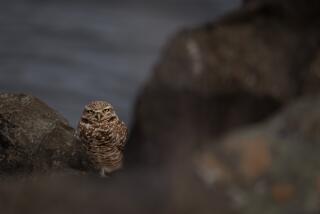Just when you thought spiders couldn’t get creepier
On the creepiest day of the year, we have news about one of the creepiest bugs around: the spider.
Researchers have discovered the largest orb-weaving spider ever seen, a (relatively) massive creature whose body is about 1 1/2 inches across and whose leg span reaches 5 inches. A second group has found a specimen that is perhaps a little less creepy, although somewhat disturbing for different reasons -- a vegan spider.
The newly discovered orb-weaver, called Nephila komaci, was discovered in Madagascar and Africa by a team led by Matjaz Kuntner of the Slovenian Academy of Sciences and Arts. Nephila spiders are the largest web-spinning species, creating circular webs as large as 3 feet in diameter. They are also good subjects for studying sexual dimorphism because only females grow large. Males are about one-fifth the size of females, as tiny as common household spiders.
Kuntner and his colleagues reported:doi/10.1371/journal.pone.0007516 in the online journal PLoS One that they originally found the new species as a preserved specimen in the collection of the Plant Protection Research Institute in Pretoria, South Africa. Several expeditions to South Africa failed to find a living example, and researchers thought perhaps it had gone extinct.
Finally, however, a South African colleague found a male and two females living in the Tembe Elephant Park in KwaZulu-Natal, South Africa. The new species was named after Kuntner’s best friend, Andrej Komac, who had encouraged him to pursue his doctorate but died in an accident about the time of the initial discoveries.
The species becomes one of more than 40,000 known species of spiders.
Until recently, researchers had believed that all 40,000 subsisted primarily on insects, although some have been known to supplement their diets with plant nectars and pollen.
But two years ago, while watching jumping spiders on an acacia plant in Mexico, entomologist Christopher J. Meehan, now at the University of Arizona but then a graduate student at Villanova University in Pennsylvania, observed a strange behavior. The spider Bagheera kiplingi (named in the late 1800s after the panther in Rudyard Kipling’s “The Jungle Book”) ignored the copious numbers of ants on the plant, and crawled over them to eat nectar from the tips of leaves.
The acacia and the ants have a mutually beneficial relationship in which the ants protect the plants from most would-be herbivores by biting them. The plant, in turn, provides the ants with housing in its swollen hollow spines and with food, including nectar and the contents of specialized leaf tips called Beltian bodies. B. kiplingi is an interloper on this relationship, stealing the food without giving anything back to the plant.
Repeated observations showed that the spider subsists almost entirely on the plant, although it will occasionally snack on ant larvae. Isotopic analysis of carbon-13 and carbon-12 in its body shows that the ratio of the two isotopes is identical to that of the plants, indicating that the plant is its primary source of sustenance, Meehan and entomologist Robert Curry of Villanova reported this month in the journal Current Biology.
The spider actively hunts food, staring at it, then sometimes backing away and staring again, Meehan said. Then it moves acrobatically through the ants, stealing the nectar and skipping out again.
More to Read
Start your day right
Sign up for Essential California for news, features and recommendations from the L.A. Times and beyond in your inbox six days a week.
You may occasionally receive promotional content from the Los Angeles Times.






